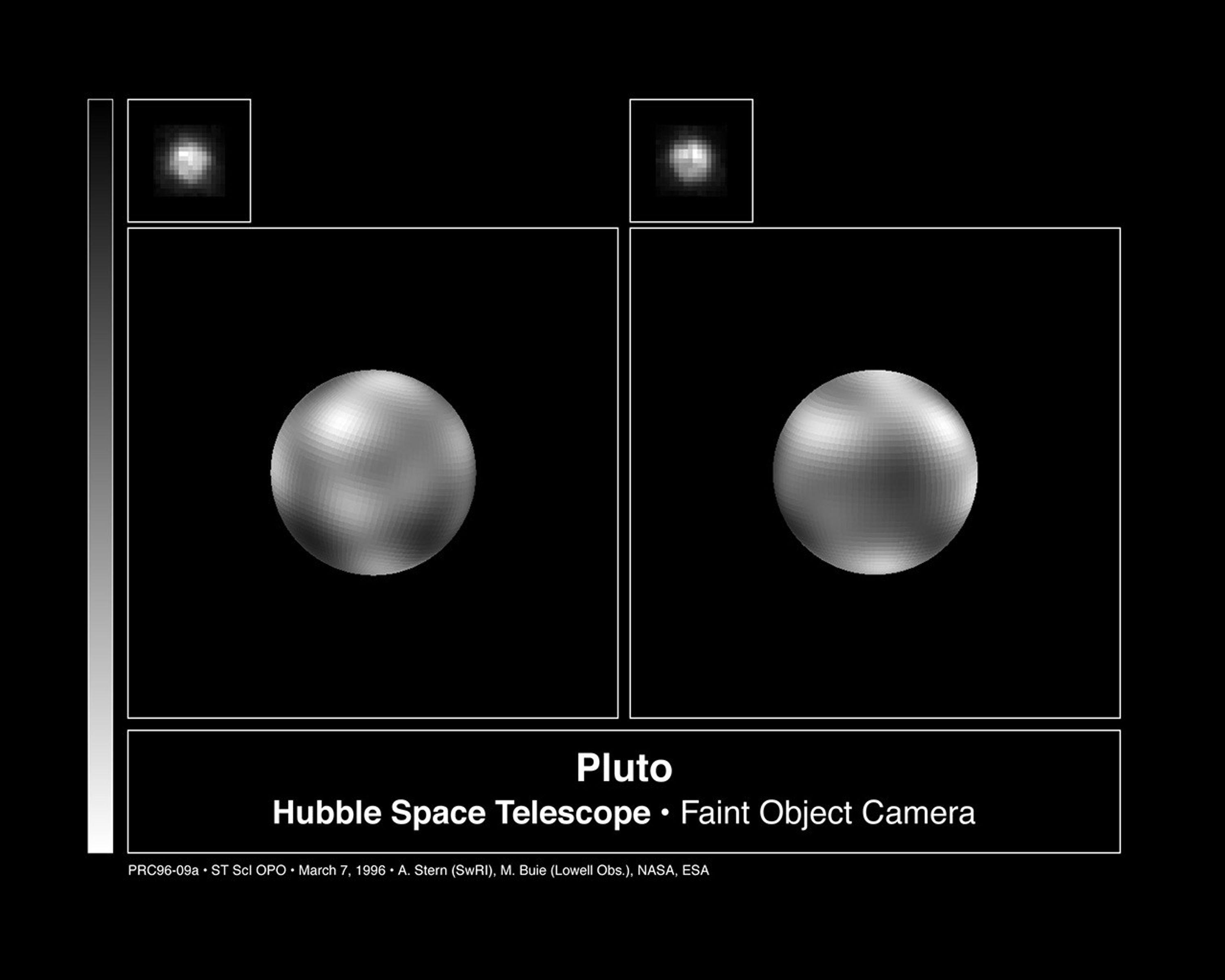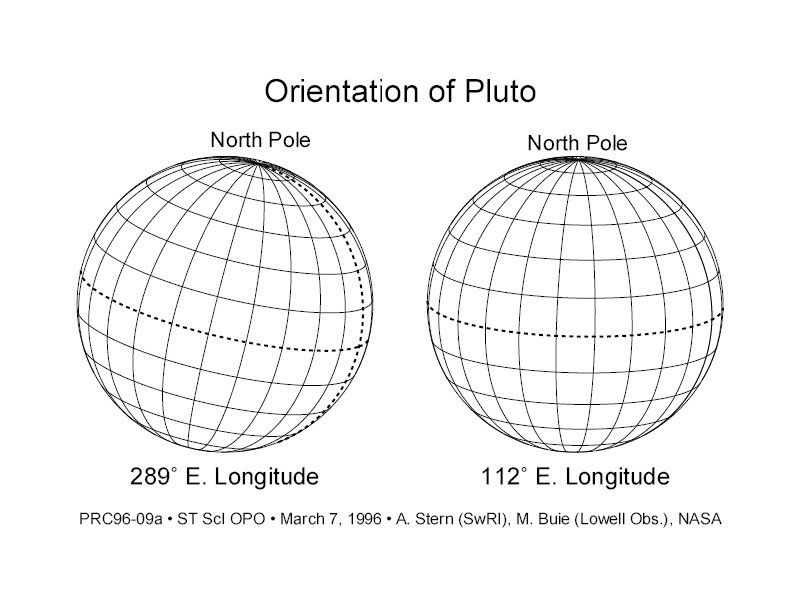For the first time since Pluto's discovery 66 years ago, astronomers have at last directly seen details on the surface of the solar system's farthest known planet. These details were seen in clear pictures, taken with the European Space Agency's Faint Object Camera (FOC) aboard NASA's Hubble Space Telescope.
Hubble's snapshots of nearly the entire surface of Pluto, taken as the planet rotated through a 6.4-day period, show that Pluto is a complex object, with more large-scale contrast than any planet, except Earth.
The images also reveal almost a dozen distinctive albedo features, or provinces, none of which have ever been seen before. They include a "ragged" northern polar cap bisected by a dark strip, a bright spot seen rotating with the planet, a cluster of dark spots, and a bright linear marking that is intriguing the scientific team analyzing the images. The images confirm the presence of icy-bright polar cap features, which had been inferred from indirect evidence for surface markings in the 1980s.
This historic new look at Pluto helps pave the way for a proposed Pluto flyby mission early in the next century. Pluto is the only solar system planet not yet visited by a spacecraft.
"Hubble is providing the first, tantalizing glimpse of what Pluto will be like when we get there," said Dr. Alan Stern of Southwest Research Institute's Boulder, Colorado research office. Dr. Stern led the team who used Hubble to obtain the most detailed view yet of Pluto. The Pluto imaging team also includes Dr. Marc Buie of Lowell Observatory in Flagstaff, Arizona, and Dr. Laurence Trafton of the University of Texas in Austin, Texas. This team of planetary scientists used the FOC aboard the Hubble to obtain over a dozen high-quality visible and ultraviolet images of Pluto in mid-1994. These images have now been carefully reduced and analyzed.
"These results and the maps we constructed from them are much better than I ever hoped for," said Dr. Buie. "It's fantastic. Hubble has brought Pluto from a fuzzy, distant dot of light, to a world which we can begin to map, and watch for surface changes. Hubble's view of tiny, distant Pluto is reminiscent of looking at Mars through a small telescope," said Stern.
Some of the sharp variations across Pluto's surface detected in the Hubble images may potentially be caused by such topographic features as basins and fresh impact craters (as found on Earth's Moon). However, most of the surface features unveiled by Hubble are likely produced by the complex distribution of frosts that migrate across Pluto's surface with its orbital and seasonal cycles. Pluto is so far from the Sun that even nitrogen, carbon monoxide, and methane gases partially freeze onto its surface during the long period (about 100 years) when it is farthest from the Sun.
The Hubble images reveal much more surface variety on Pluto than on other icy objects in the outer solar system, including Pluto's oft-cited twin, Neptune's large moon Triton. According to Dr. Trafton, "...the HST images are confirming Pluto's individuality. It isn't a twin of Triton after all."
During the short, warm season around Pluto's closest approach to the Sun, these ices sublimate (go directly back to a gas), thickening Pluto's atmosphere. "The light areas are as bright as fresh Colorado snow, and the darker areas are more reminiscent of the brightness of a dirty snow," said Stern. The darkest regions likely result from hydrocarbon "residues" from the effects of ultraviolet sunlight and cosmic rays on Pluto's complex chemical melange of surface ices.
Pluto is two-thirds the size of Earth's Moon, and 1,200 times farther away. Pluto's apparent size in the sky is so small (0.1 arcseconds, which equals 1/36,000th of a degree), that 18,000 Plutos would need to be lined up to match the diameter of the full Moon. This puts Pluto's surface below the resolution limit of the largest ground-based telescopes; as a result it has been impossible to directly see any significant detail on Pluto before these Hubble observations.
Viewing such a remote and small body has been so difficult that Pluto's moon Charon wasn't detected until 1978, despite the fact that Pluto itself was discovered by Clyde Tombaugh in 1930.
Shortly after its launch in 1990, the Hubble Space Telescope first peered at Pluto and clearly distinguished the planet and its satellite (which is only 1/3,000th of a degree away) as two separate objects. However, a detailed look at Pluto's surface had to wait until Hubble's optics were improved during the late-1993 servicing mission.
The Advanced Camera, planned to be installed on Hubble in 1999, will yield slightly better images of Pluto. This will be our best view of the distant planet until space probes eventually make the long trek across the solar system.
BACKGROUND INFORMATION: PLUTO – THE SOLAR SYSTEM'S FINAL FRONTIER
Though discovered early in the century - before the space age of Sputnik, Apollo, and Voyager - the planet Pluto remains as dim and remote as its mythological namesake, the Roman god of the underworld.
Super-Comet or Ice Dwarf?
Pluto is so unique it almost defies classification. Though it orbits the Sun, Pluto neither qualifies as a terrestrial nor as a gas giant planet. Though it behaves like a comet by periodically warming and losing its atmosphere into space, Pluto is far too large for that category. Pluto may be the last survivor of a lost population of objects called ice dwarfs that inhabited the primeval solar system. Neptune's moon Triton might be a distant cousin, and other relatives may dwell in the Kuiper Belt, a disk of ice debris left behind from the solar system's birth. Pluto and Triton survive because they have found gravitational niches in the solar system where they remain in stable orbits. Pluto is in a resonance orbit with Neptune (Neptune circles the Sun three times for every two orbits of Pluto), which means that Pluto never gets close enough to Neptune to be thrown out the solar system. Triton was gravitationally captured by Neptune and was therefore prevented from being ejected from the planetary region. It is believed that all of the other ice dwarfs formed inside 50 AU were ejected by gravitational interactions due to the giant planets in the ancient past.
The Double Planet
Pluto and Charon is the best example of a double planet, which occurs when two bodies are reasonably close in mass and so orbit around a common center of gravity - or barycenter (analogous to two children balancing on a teeter-totter). Charon may have been born through a head-on collision between Pluto and another large ice body, in much the same way as the Earth-Moon system is believed to have formed. According to computer models, some of the debris from this giant impact on Pluto went into orbit around Pluto and coalesced to form Charon.
A Dynamic, Unique Atmosphere
Despite its small size and remote location in the solar system, Pluto undergoes dramatic seasonal changes driven largely by Pluto's highly elliptical orbit, which carries it as close as 2.8 billion miles to the Sun (inside Neptune's orbit) and as far as 4.6 billion miles from the Sun. As Pluto recedes from the Sun, much of its atmosphere is believed to freeze out onto the surface. This explains the abundance of fresh white ice on the surface. Pluto essentially "launders" its surface by evaporating dirty, old ice in the summer, and depositing a fresh new layer of ice each 248-year orbit.
Pluto passed its closest point to the Sun in late 1989. As a result, it presently enjoys a relatively "balmy" surface temperature near -350 degrees Fahrenheit in the dark areas, and a cooler -380 degrees in the ice areas. It is likely that this sets up tremendous pressure differences at the surface, creating high wind speeds in Pluto's tenuous atmosphere. For astronomers it's a rare and ideal time for viewing Pluto and studying these changes.
The last time Pluto was this close to the Sun (and Earth!), George Washington was a boy!































